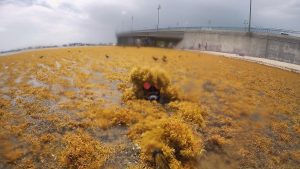
photo by john turnbull
What’s up with the giant mat of seaweed floating towards us? Where did it come from and why is it here?
The monster comes from the home of the Bermuda Triangle: the Sargasso Sea. This isn’t a sea of water—it’s a vast golden sea of seaweed. It’s an area of the Atlantic Ocean of more than two million square miles (about the size of the United States) covered with dense mats of a floating seaweed called Sargassum.
Sargassum has air-filled bubbles called bladders, which act like water wings to keep the seaweed afloat for its entire life. The fronds hang down into the water of the Sargasso, which is almost as calm as a lake, but very deep—the bottom in places lies more than two miles below the quiet surface. Sargassum drifts endlessly, never needing to touch the land.

photo by Jordan Harrison
Why does all this seaweed hang out in the middle of the ocean? The Sargasso region is surrounded by powerful currents that swirl around like water in the drain of a sink. The force of the currents pulls the seaweed masses into the center of the spiral, trapping them there.
Occasional clumps of this drifting seaweed have long escaped currents and drifted to beaches in Florida, the Caribbean, and as far away as North Africa. But since 2011, enormous mats of sargassum have invaded beaches in summer. The masses of seaweed are sometimes too thick for swimmers to get into the water. Sea turtles can’t reach the sand to lay eggs. Mounds of seaweed decompose into a smelly mess that sends tourists fleeing, and can cause fish kills. Clean-up can cost millions of dollars.

photo by Jordan Harrison
Why this sudden, enormous invasion of sargassum? Seawater is warmed by climate change, which accelerates seaweed growth. The ocean is also polluted with fertilizers from huge, industrial-size farms and ranches. Droughts in places as far away as the Sahara Desert are causing erosion, and the windblown soil ends up in the ocean, adding to the nutrient load. And too many nutrients fertilize the water, resulting in too much seaweed.
For more about seaweed, please check out my book The Forest in the Sea.






The positive effects of sargassum far outweigh negative impacts. If tourist don’t want to deal with it…GO ELSEWHERE!
Are there any useful products or potential healing vitamins that can be created from this particular seaweed?
To the best of my knowledge I’m only things for plants are made.
In particular something call Mulch fertilizer
Is sagassum also a carbon sink like the Amazon rain forest? Maybe the lungs of the ocean.
Yes, exactly! Seaweed creates a huge amount of the oxygen we breathe, and sequesters carbon.
As earth’s population continues to shrink from disease and pharmaceutical products, I hope the abundance of fertilizers will also decrease to save the oceans globally.
Where on this flat Earth did you hear that the Earth’s population is shrinking?
Fertilizer is also used on tiny farms, lawns, golf courses, vegetable plots, vineyards, flower beds, flower pots, tree farms, and so on. Large and industrialized denotes evil climate-changing greed. Don’t overlook all the little things that pollute, e.g. washing dishes or taking a bath.
You’re absolutely right, that’s an excellent point.
Chris
Cox
I find this so interesting! What has caused this massive amount of seaweed to start building and coming toward beaches? Please continue to post information on this subject! I am quite interested! Thank you Alma Cantu. From Texas Gulf Coast area in Jefferson County!
How long will it be here. I will read book also.
No one knows for sure, but best guess is the worst will hit Florida in July, and it will take weeks to decompose.
Thanks for sharing this information.
Raiza Perrault
Hollywood, FL